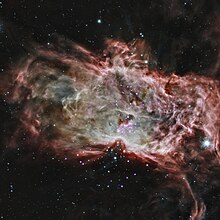astro.wikisort.org - Galaxy
The Flame Nebula, designated as NGC 2024 and Sh2-277, is an emission nebula in the constellation Orion. It is about 900 to 1,500 light-years away.
| Emission nebula | |
|---|---|
 The Flame Nebula (NGC 2024) - based on Chandra X-Ray and Spitzer Infrared images. | |
| Observation data: J2000.0 epoch | |
| Right ascension | 05h 41m 54s |
| Declination | −01° 51′ 0.0″ |
| Distance | 1350[1] ly (415 pc) |
| Apparent magnitude (V) | 10[2] |
| Apparent dimensions (V) | 30'x30' |
| Constellation | Orion |
| Physical characteristics | |
| Radius | 6 ly |
| Designations | NGC 2024 and Sharpless 277 |
The bright star Alnitak (ζ Ori), the easternmost star in the Belt of Orion, shines energetic ultraviolet light into the Flame and this knocks electrons away from the great clouds of hydrogen gas that reside there. Much of the glow results when the electrons and ionized hydrogen recombine. Additional dark gas and dust lies in front of the bright part of the nebula and this is what causes the dark network that appears in the center of the glowing gas. The Flame Nebula is part of the Orion molecular cloud complex, a star-forming region that includes the famous Horsehead Nebula.
At the center of the Flame Nebula is a cluster of newly formed stars,[3] 86% of which have circumstellar disks.[4] X-ray observations by the Chandra X-ray Observatory[5][6] show several hundred young stars, out of an estimated population of 800 stars.[7] X-ray and infrared images indicate that the youngest stars are concentrated near the center of the cluster.[8][9]
Gallery
- Optical image in B, V and R filters, from La Silla Observatory
- Infrared image, from 2MASS
- Near-infrared image, from VISTA
- Visible light wide-field view of region of Orion's Belt and the Flame Nebula
- NGC 2024 seen by the Chandra X-ray Observatory
- Flame Nebula and Horsehead Nebula
- Horsehead and Flame Nebulae in H-alpha
See also
- Alnitak (ζ Ori)
- Horsehead Nebula
- Orion Nebula
References
- Meyer, M. R.; et al. (2008). "Star Formation in NGC 2023, NGC 2024, and Southern L1630". In Reipurth, B. (ed.). Handbook of Star Forming Regions, Volume II: The Southern Sky ASP Monograph Publications. Vol. 5. p. 43. Bibcode:2008hsf1.book..662M. ISBN 978-1-58381-670-7.
- "Is the Flame nebula easier to see than the Orion nebula?". stargazerslounge.com. Retrieved 2018-03-24.
- Haisch, K. E. Jr.; Lada, E. A.; Lada, C. J. (2000). "A Near-Infrared L-Band Survey of the Young Embedded Cluster NGC 2024". Astronomical Journal. 120 (2): 1396–1409. arXiv:astro-ph/0006219. Bibcode:2000AJ....120.1396H. doi:10.1086/301521.
- Haisch, K. E. Jr.; et al. (2001). "A Mid-Infrared Study of the Young Stellar Population in the NGC 2024 Cluster". Astronomical Journal. 121 (3): 1512–1521. arXiv:astro-ph/0012482. Bibcode:2001AJ....121.1512H. doi:10.1086/319397.
- Skinner, S.; Gagné, M.; Belzer, E. (2003). "A Deep Chandra X-Ray Observation of the Embedded Young Cluster in NGC 2024". Astrophysical Journal. 598 (1): 375–391. arXiv:astro-ph/0306566. Bibcode:2003ApJ...598..375S. doi:10.1086/378085.
- Broos, P. S.; et al. (2013). "Identifying Young Stars in Massive Star-forming Regions for the MYStIX Project". Astrophysical Journal. 209 (2): 32. arXiv:1309.4500. Bibcode:2013ApJS..209...32B. doi:10.1088/0067-0049/209/2/32.
- Kuhn, M. A.; Getman, K. V.; Feigelson, E. D. (2015). "The Spatial Structure of Young Stellar Clusters. II. Total Young Stellar Populations". Astrophysical Journal. 802 (1): 60. arXiv:1501.05300. Bibcode:2015ApJ...802...60K. doi:10.1088/0004-637X/802/1/60.
- Getman, K. V.; Feigelson, E. D.; Kuhn, M. A. (2014). "Core-Halo Age Gradients and Star Formation in the Orion Nebula and NGC 2024 Young Stellar Clusters". Astrophysical Journal. 787 (2): 109. arXiv:1403.2742. Bibcode:2014ApJ...787..109G. doi:10.1088/0004-637X/787/2/109.
- Nemiroff, R.; Bonnell, J., eds. (10 May 2014). "Inside the Flame Nebula". Astronomy Picture of the Day. NASA. Retrieved February 14, 2015.
External links
- NGC 2024 at Astrophotography
- "NGC 2024". SIMBAD. Centre de données astronomiques de Strasbourg.
- Nemiroff, R.; Bonnell, J., eds. (13 July 1999). "The Flame Nebula in Infrared". Astronomy Picture of the Day. NASA.
- The Flame Nebula on WikiSky: DSS2, SDSS, GALEX, IRAS, Hydrogen α, X-Ray, Astrophoto, Sky Map, Articles and images
На других языках
[de] Flammennebel
Der Flammennebel (auch als Flammender Baum oder NGC 2024 bezeichnet) ist ein Emissionsnebel im Sternbild Orion. Der Flammennebel ist Teil des Orion-Komplexes, einem Sternentstehungsgebiet, zu dem unter anderem auch IC 434 mit dem Pferdekopfnebel und der Orion-Nebel gehören.- [en] Flame Nebula
[es] Nebulosa de la Flama
NGC2024 o la nebulosa de la Flama es una nebulosa de emisión que aparenta estar en llamas. Se encuentra cerca de la estrella más oriental del cinturón de Orión, Alnitak. Erróneamente se dice que es una nebulosa oscura.[ru] NGC 2024
NGC 2024 или Туманность «Пламя» или Туманность «Факел» (другое обозначение — CED 55P) — эмиссионная туманность в созвездии Орион.Другой контент может иметь иную лицензию. Перед использованием материалов сайта WikiSort.org внимательно изучите правила лицензирования конкретных элементов наполнения сайта.
WikiSort.org - проект по пересортировке и дополнению контента Википедии






